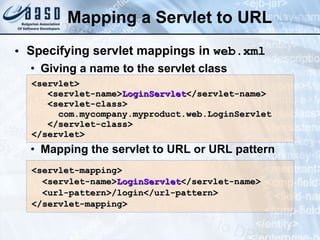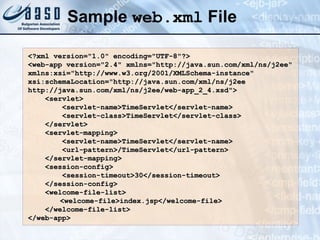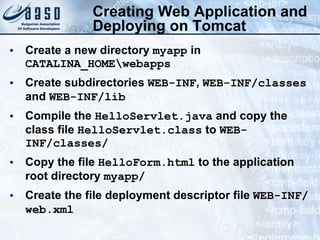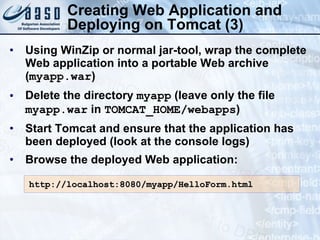Ad
Web Applications and Deployment
- 1. Java Web Applications and Deployment Svetlin Nakov Borislava Spasova
- 2. Contents Using Tomcat Web Application Server What is a Web Container? What is Apache Tomcat? Installing and Running Tomcat Tomcat Directory Structure Java Web Applications Web Application Structure and WAR Files The Deployment Descriptor ( web.xml ) Mapping a Servlet to URL Creating Web Applications and Deploying on Tomcat
- 3. Using Tomcat Web Application Server
- 4. What is a Web Container? Web containers are Java server applications Provide an environment for execution of Java Web applications, servlets, JSP, etc. Web containers Maintain the life cycle of the servlets – call their doGet(…) and do Post (…) methods Issue a thread for each request Give the servlet the HTTP request and return its response to the client Apache Tomcat is an example of a Web container
- 5. What Is Tomcat? Apache Tomcat is free, open source Java Web Application Server Java EE Web container Can run as standalone HTTP server or can be attached to another HTTP server Tomcat can host: Java Web applications Servlets, JSP, custom tags, JSF Web Services
- 6. Web Container and Web Server Integration A Web container may be used to process HTTP requests by executing the service method on an HttpServlet object
- 7. Installing Tomcat Tomcat can be freely downloaded from its official Web site: http://tomcat.apache.org/ Requirements Java 5 or later on Windows / Linux / Unix / etc. Distributions Windows executable installation package Runs as Windows service ZIP / GZip archive Manually started / stopped by a script
- 8. Running Tomcat When installed from the ZIP archive Tomcat can be started by a script JAVA_HOME environment variable must point to JDK 6 or later installation folder: Avoid spaces in the paths! bin/startup.bat set JAVA_HOME= C:\Progra~1\Java\jdk1. 6 .0_ 23 rem This space in the path will cause problems! set JAVA_HOME="C:\Program Files\Java\jdk1. 6 .0_ 23"
- 9. Tomcat Directory Structure (as in Tomcat 7.0.11) $CATALINA_HOME = <some_dir>/apache-tomcat- 7 . 0 . 1 1 bin/ Binary executables and scripts conf/ Configuration files logs/ Destination directory for log files temp/ Directory used by the JVM for temporary files webapps / Contains all Web applications deployed on the Web Server Can be used to deploy applications work/ Scratch directory used by Tomcat for holding temp files and directories
- 10. Java Web Applications Structure and Deployment
- 11. Java Web Applications Java Servlet specification defines a Web application as a collection of: HTML pages, JSP pages and others Servlets and compiled Java classes Resources (images, CSS, files, etc.) Web applications are bundled and can be executed in any Web container Can compile into a W eb AR chive File (.WAR file)
- 12. Web Applications Structure Java Web applications should have the following directory structure: webapp/ The application root directory. Contains the files, accessible from the Web: HTML, CSS, JSP, images, ... WEB-INF/ Special folder for the Web application lib/ Libraries (JAR files) required by the application (e.g. JDBC drivers) classes/ Compiled Java classes required by the application (servlets, beans, etc.) web.xml Special configuration file called " Web application deployment descriptor "
- 13. Example – Login / Logout Web Application Structure The root directory of the Web application Classes of the application (including servlets) Libraries of the application (e.g. JDBC drivers) Deployment descriptor (configuration file) Public accessible files (HTML, JSP, CSS, ...) Special directory
- 14. WAR Files Java Web applications are compiled and packed into WAR files WAR files are JAR archives (ZIP files) that contain Java Web application Consists of all the files of the application HTML, JSP and other files Classes and libraries ( WEB-INF/classes/ , WEB-INF/lib/ ) Deployment descriptor ( WEB-INF/ web.xml ) Can be deployed on any Web container
- 15. WAR Files – Example With the Tomcat distribution comes an example WAR file : sample.war CATALINA_HOME\webapps\docs\appdev\sample\sample.war
- 16. The Deployment Descriptor ( web.xml ) The file <my-web-app>\WEBINF\web.xml is called “ Web application deployment descriptor ” It is read when server deploys the application Many servers have "hot deploy" option Basic format of web.xml file: Order of the elements within the <web-app> tag is important! <web-app version="2.4" xmlns="http://java.sun.com/xml/ns/j2ee" xmlns:xsi="http://www.w3.org/2001/XMLSchema-instance" xsi:schemaLocation="http://java.sun.com/xml/ns/j2ee http://java.sun.com/xml/ns/j2ee/web-app_2_4.xsd"> ... </web-app>
- 17. What is Defined in The Deployment Descriptor? The deployment descriptor of the Web application ( web.xml ) can define: The application name and description Servlet classes and mappings to URL Servlet configuration (init) parameters Servlet filters definitions and filter mappings Application context parameters Welcome files, error pages, MIME mappings Tag libraries references Security and authentication settings
- 18. Mapping a Servlet to URL Specifying servlet mappings in web.xml Giving a name to the servlet class Mapping the servlet to URL or URL pattern <servlet> <servlet-name> LoginServlet </servlet-name> <servlet-class> com.mycompany.myproduct. web. LoginServlet </servlet-class> </servlet> <servlet-mapping> <servlet-name> LoginServlet </servlet-name> <url-pattern>/login</url-pattern> </servlet-mapping>
- 19. Adding initialization parameters to servlets Accessing the servlet initialization parameters Configuring The Servlet Initialization Parameters <servlet> <servlet-name>InitTest</servlet-name> <servlet-class>myservlets.InitServlet</servlet-class> <init-param> <param-name> username </param-name> <param-value>admin</param-value> </init-param> <init-param> <param-name>emailAddress</param-name> <param-value>admin@localhost</param-value> </init-param> </servlet> getServletConfig().getInitParameter(" username ");
- 20. Sample web.xml File <?xml version="1.0" encoding="UTF-8"?> <web-app version="2.4" xmlns="http://java.sun.com/xml/ns/j2ee" xmlns:xsi="http://www.w3.org/2001/XMLSchema-instance" xsi:schemaLocation="http://java.sun.com/xml/ns/j2ee http://java.sun.com/xml/ns/j2ee/web-app_2_4.xsd"> <servlet> <servlet-name>TimeServlet</servlet-name> <servlet-class>TimeServlet</servlet-class> </servlet> <servlet-mapping> <servlet-name>TimeServlet</servlet-name> <url-pattern>/TimeServlet</url-pattern> </servlet-mapping> <session-config> <session-timeout>30</session-timeout> </session-config> <welcome-file-list> <welcome-file>index.jsp</welcome-file> </welcome-file-list> </web-app>
- 21. Creating Web Application and Deploying on Tomcat Create a new directory myapp in CATALINA_HOME\webapps Create subdirectories WEB-INF , WEB-INF/classes and WEB-INF/lib Compile the HelloServlet.java and copy the class file HelloServlet.class to WEB-INF/classes/ Copy the file HelloForm.html to the application root directory myapp / Create the file deployment descriptor file WEB-INF/web.xml
- 22. Creating Web Application and Deploying on Tomcat (2) <?xml version="1.0" encoding="UTF-8"?> <web-app version="2.4" xmlns= "http://java.sun.com/xml/ns/j2ee" xmlns:xsi= "http://www.w3.org/2001/XMLSchema-instance" xsi:schemaLocation="http://java.sun.com/xml/ns/j2ee http://java.sun.com/xml/ns/j2ee/web-app_2_4.xsd"> <servlet> <servlet-name> Hello Servlet</servlet-name> <servlet-class> Hello Servlet</servlet-class> </servlet> <servlet-mapping> <servlet-name> Hello Servlet</servlet-name> <url-pattern>/ Hello Servlet</url-pattern> </servlet-mapping> </web-app> web.xml
- 23. Creating Web Application and Deploying on Tomcat (3) Using WinZip or normal jar-tool, wrap the complete Web application into a portable Web archive ( myapp.war ) Delete the directory myapp (leave only the file myapp.war in TOMCAT_HOME/webapps ) Start Tomcat and ensure that the application has been deployed (look at the console logs) Browse the deployed Web application: http://localhost:8080/myapp/HelloForm.html
- 24. Problems Download and install Tomcat (use the ZIP distribution, not the Windows executable). Deploy and r un the sample application from: CATALINA_HOME\webapps\docs\appdev\sample\sample.war Manually, without using Eclipse IDE, create a simple Java Web application consisting of a servlet that displays all the headers from the HTTP request. Map it to the URL pattern *.php . Create WAR archive with the application and deploy it on Tomcat. Try to browse the resource / index.php .
- 25. Homework Download and install Tomcat at home. Use the ZIP distribution, not the Windows executable. Manually, without using any IDE, create a simple Web application that consists of a HTML form for entering a number and a servlet that calculates a square root of the number. Pack the application as WAR archive and deploy it on Tomcat. Find information in Google about servlet filters . Add a servlet filter to the application that show current date and time on each page.
Editor's Notes
- #13: webapp directory is considered the Web application root directory. All JSP, HTML, JavaScript files, and other resources are under this directory. The WEB-INF directory contains resources used by the application, WEB-INF is not in the public document root—no files contained in this directory structure are accessible by a client. The classes directory (under WEB-INF) contains servlets, beans, and utility classes needed for webapp's operation. lib directory (under WEB-INF) contains Java archive files (JARs), such as the JDBC driver or tag library, on which webapp depends. If a class is present in a JAR file and in the classes directory, the class loader loads the one in the classes directory.
- #19: Notes Order matters: servlet before servlet-mapping JSP: Use jsp-file instead of servlet-class

















































































































